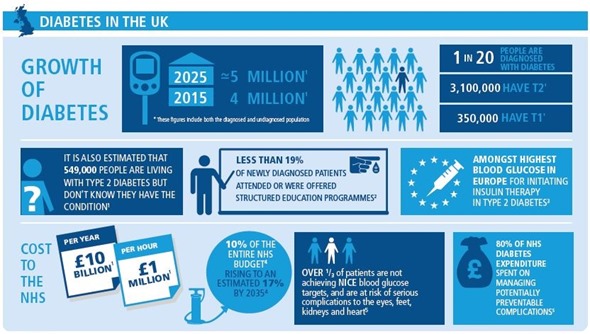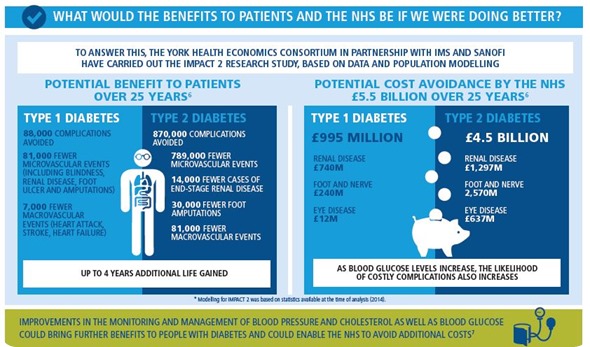Sanofi, Diabetes UK and JDRF today announce the publication of IMPACT 2 in the journal Diabetic Medicine. This new study shows that, if sustained, even modest improvement in blood glucose levels can provide significantly improved outcomes for the 3.5 million people diagnosed with diabetes in the UK.
As a result, if applied to the whole diabetes population, almost a million serious medical complications, such as blindness, amputation and kidney failure could be avoided over 25 years, improving the lives of people with diabetes. Better management of blood glucose levels over the same period could equate to a cost avoidance of £5.5 billion for the NHS.

IMPACT 2 is a study based on data and population modeling. It is the outcome of a collaboration between Diabetes UK, JDRF and Sanofi, and the analysis was completed by IMS and the York Health Economics Consortium. It quantifies the patient and financial benefit over 25 years of earlier intervention for better controlling blood glucose. The findings highlight results that could have a significant impact for people with diabetes and NHS budgets:
- For people with Type 2 diabetes the figure of potentially preventable complications is 870,000 equating to a cost avoidance of £4.5 billion over 25 years for the NHS.
- For people with Type 1 diabetes the figure of potentially preventable complications is 88,000 equating to a cost avoidance of just under £1 billion over 25 years for the NHS.
IMPACT 2 demonstrates that even small improvements in blood glucose levels can result in huge benefits for people with diabetes with the potential to stop 23,000 people suffering severe kidney failure, almost 160,000 leg ulcers and amputations and over 50,000 people suffering severe loss of vision. This should be a priority for all those involved in providing care for people with diabetes.”
“Preventing Type 2 diabetes through public health initiatives is of course the best way of reducing spend long-term, however much greater efforts are needed to ensure all people with diabetes get the support and care they need for a good quality of life and better health outcomes.”
Chris Askew, Diabetes UK Chief Executive.
Karen Addington, Chief Executive of JDRF in the UK, agreed, adding, “People with Type 1 diabetes are routinely still receiving poorer care and are less likely to be meeting NICE recommended blood glucose targets, when compared to people with Type 2 diabetes. The IMPACT 2 results show the benefit to people living with Type 1 diabetes and the NHS in providing appropriate care, support and education to help people manage their condition.”
The report is published against a backdrop of blood glucose management in the UK being amongst the worst in Europe and around two thirds of all people with diabetes in England not achieving the treatment targets recommended by National Institute for Health and Care Excellence (NICE). In addition, despite well-documented benefits of reducing complications through timely control of blood glucose, levels are too high before additional interventions are provided. On average, people in the UK with Type 2 diabetes have the highest blood glucose levels (HbA1c 9.8%) when compared to nine other developed countries, at the point of insulin initiation.

“The scale of the findings have important implications for clinical practice in the NHS. In a cost constrained healthcare system, interventions, medical or otherwise, will always be required to justify any improvement in patient outcome against cost. For the first time clinicians have clear evidence of the reduction in spending that could be conferred by reducing serious diabetes related complications through better blood glucose control,” says Professor Steve Bain, Professor in Medicine (Diabetes), University of Swansea.
NHS spend on diabetes is already considerable and on the increase. IMPACT 1 showed that diabetes costs the NHS £10 billion each year – around £1 million an hour – which is about 10% of the entire NHS budget. Nearly 80% of these costs are attributable to treating avoidable complications, which could potentially be reduced through better management of diabetes, including improved blood glucose control. Diabetes is now the leading preventable cause of sight loss in people of working age in the UK and 135 amputations are carried out every week as a result of poor management of the condition.
Diabetes is a major healthcare problem with a large and increasing number of people in the UK suffering from avoidable microvascular complications such as kidney disease and foot amputations because their blood glucose levels are too high. IMPACT 2 quantifies the reduction in the number of complications, and the potential cost avoidance if modest improvements to patients’ blood glucose levels were made.”
“There is the potential to generate real improvements in outcomes for patients with diabetes by making even small but sustained improvements in their blood glucose levels,”
Dr Mike Baxter, Consultant Advisor to Sanofi Diabetes and lead author of the study.
Diabetes in the UK
There are 3.5 million people in the UK currently diagnosed with diabetes and if current trends continue, approximately five million people will have diabetes by 2025.2 It is predicted that 11.9 million people in the UK are at risk of Type 2 diabetes. Additionally, it is believed that there are approximately 549,000 people in the UK who have Type 2 diabetes but do not know it as they have not yet been diagnosed. The estimated split between people with Type 2 and Type 1 diabetes is 90:10.
Diabetes is a condition where there is too much glucose in the blood because the body cannot use it properly. If not managed well, both Type 1 and Type 2 diabetes can lead to devastating complications. Diabetes is the leading cause of preventable sight loss in people of working age in the UK and is a major cause of lower limb amputation, kidney failure and stroke.
People with Type 1 diabetes cannot produce insulin. Type 1 diabetes is treated by daily insulin doses - taken either by injections or via an insulin pump – a healthy diet and regular physical activity.
People with Type 2 diabetes do not produce enough insulin or the insulin they produce isn’t being used properly (known as insulin resistance). Type 2 diabetes occurs because family history, age, ethnic background and lifestyle factors put someone at increased risk. The most potent risk factor for Type 2 diabetes is obesity. Type 2 diabetes is initially treated with a healthy diet and increased physical activity. Over time, tablets and/or insulin may be required.